Henri-Pierre Picou
Henri-Pierre Picou (Nantes 27 February 1824 – 17 July 1895) was a French painter.[1][2] His oeuvre began with portraits and classical historical subject matter but he later moved on to allegorical and mythological themes.[3]
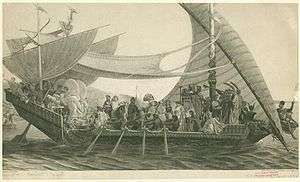
He was an academic painter and one of the founders of the Neo-Grec school, along with his close friends Gustave Boulanger, Jean-Léon Gérôme, and Jean-Louis Hamon, also academic painters. All of them studied in the workshops of both Paul Delaroche and later Charles Gleyre. Picou's style was noticeably influenced by Gleyre. While the rest of the group generally painted classical and mythological subjects, Picou also received commissions for large religious frescoes from many churches, including the Église Saint-Roch.[4]
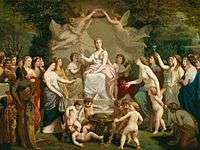
His artistic debut was at the Salon in 1847. The next year he was awarded a second-class medal for his painting, Cléopâtre et Antoine sur le Cydnus. Also known as Cleopatra on the Cydnus, it is commonly regarded as Picou's masterpiece. This showing at the Salon in 1848 was written about by the critic Théophile Gautier, who felt that the subject matter was too ambitious, but also said that "As it is, it gives the best hope for the future of the young artist, and ranks among the seven or eight most important paintings of the Salon."[5] In 1875, the painting was exhibited in New York, and afterward found lodgment on the walls of a private art gallery in San Francisco.[6]
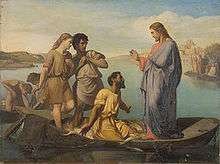
Picou maintained a large workshop in Paris on the Boulevard de Magenta, which provided him room to work on his expansive frescoes. His popularity continued to rise and he went on to win the Second Prix de Rome in 1853 for his painting, Jésus chassant les vendeurs du Temple (The Moneylenders Chased from the Temple), and another second-class medal for his Salon painting in 1857. From his debut in 1847, he was a regular at the Salon, showing almost every year until his final exhibit in 1893.[3][7] He has been called the most fashionable painter towards the close of the Second French Empire.[1]
Gallery
_by_Henri_Pierre_Picou.jpg) The Escape
The Escape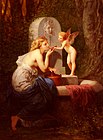 At The Fountain (1880)
At The Fountain (1880)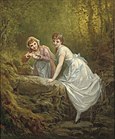 The Flower Pickers (1881)
The Flower Pickers (1881)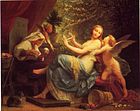 Innocence Seduced by Love (1886)
Innocence Seduced by Love (1886)
Notes
- Bryan, Michael (1904). Bryan's Dictionary of Painters and Engravers. IV. London: The Macmillan Company. p. 115.
- "Artist name". Retrieved 26 June 2010.
- Vapereau, Gustave (1893). Dictionnaire universel des contemporains: contenant toutes les personnes notables de la France et des pays étrangers (in French) (Sixième ed.). Paris: Librairie Hachette. pp. 1249–1250.
- "ART / 4 / 2DAY". Retrieved 26 June 2010.
- Gautier, Théophile (April 1848). Salon de 1848 (in French). La Presse.
Tel qu'il est, il donne les meilleures espérances pour l'avenir du jeune artiste, et se classe parmi les sept ou huit toiles les plus importantes du Salon.
- Shepp, Daniel B. (1905). Shepp's library of history and art: a pictorial history of all lands and times; the great incidents of history set forth by the magic pencils of the world's greatest artists. Philadelphia, Pennsylvania: Globe Bible Publishing Company. p. 118.
- Bellier de la Chavignerie, Emile; Auvray, Louis (1885). Dictionnaire général des artistes de l'école française depuis l'origine des arts du dessin jusqu'à nos jours: architectes, peintres, sculpteurs, graveurs et lithographes (in French). Paris: Librairie Renouard. p. 267.
Further reading
- "Tome XVIII". Gazette des Beaux-Arts (in French). Paris. 1 January 1865. p. 351.
- Bénézit, E. Dictionnaire des peintres, sculpteurs, dessinateurs et graveurs, Gründ, 1999.
- Frimmmel, Lexikon de Weiner Gemälde-Sammign, 1 (1913) 112
- Du Camps, Maxim (1855). Les Beaux-Arts à l’Exposition Universelle de 1855 (in French). Paris: Librairie Nouvelle. p. 233.
- Maillard, E. L’Art à Nantes, 1924.
- H. Marcel, La Peintures Français de XIX e’s, 1905
- Mireur, Hippolyte. Dictionnaire des Ventes d'art, vol. 5, (1911)
- Schurr, Gerald (1975). Les Petits Maîtres de la Peinture Valeur de Demain 1820-1920. III. Paris: Éditions de l'Amateur.
- Thieme, Ulriche; Becker, Felix. Allgemeines Lexikon der Bildenden Künstler von der Antike bis zur Gegenwart.
- "Lettre élégante" (PDF). Archived from the original (PDF) on 2011-07-10.
| Wikimedia Commons has media related to Henri Pierre Picou. |